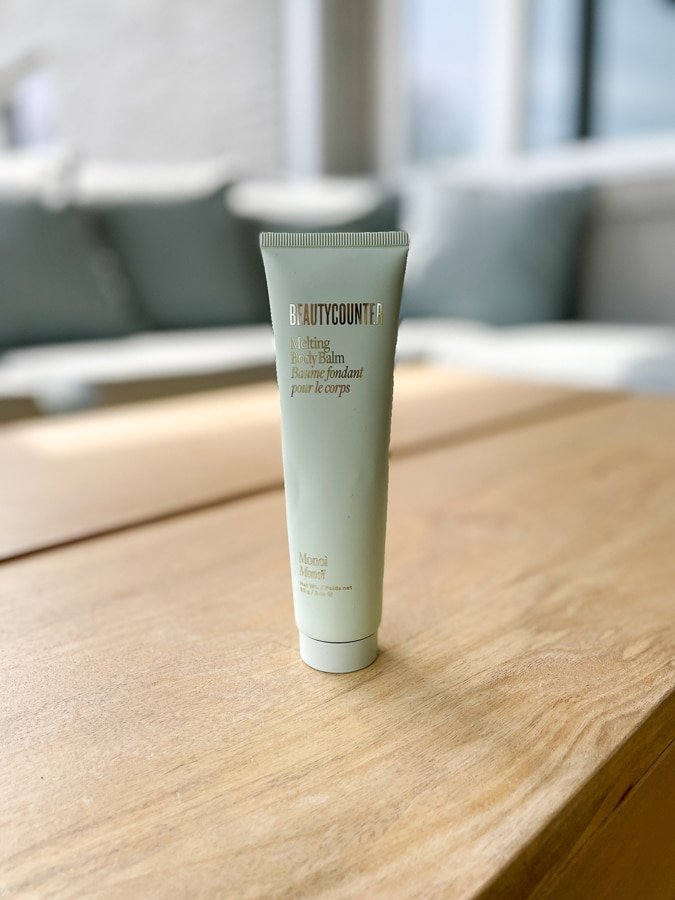[ad_1]
Key Takeaways
- The six major muscle groups you want to train are the chest, back, arms, shoulders, legs, and calves.
- You want to train each of these muscle groups at least once every 5 to 7 days for maximum muscle gain.
- Keep reading to learn which muscle groups you should workout together and the best exercises for each muscle group.
Deciding which muscle groups to train together can be confusing.
Most people say chest and triceps should be trained together, since they’re both involved in bench and overhead pressing.
Others say you should train biceps with chest because your arms will still be fresh after benching, so you might as well train them together.
Arnold was known for training his chest and back together, and if that was good enough for The Oak, then it should probably work for you, no?
Other people still say that you shouldn’t program your workouts around individual muscle groups at all, but should simply focus on doing a lot of heavy squatting, deadlifting, and bench pressing or full-body training.
So, how are you supposed to put all of this into an effective training plan that you enjoy?
Well, I have good news for you:
There is no “best” way to combine muscle groups together in your training. So long as you understand a few basic principles, there are many ways to combine them into workouts that not only work, but that you enjoy and can stick to.
Body-part “bro” splits, push pull legs, and upper/lower routines can all work equally well, and which one you use really depends on how many times per week you want to train, how many years you’ve been training, and what muscle groups you want to work on most.
And we’re going to break it all down in this article.
By the end, you’re going to know which muscle groups to train together and why, the best exercises for each, and how to create a workout routine that’s guaranteed to deliver results.
Let’s begin.
The 6 Main Muscle Groups
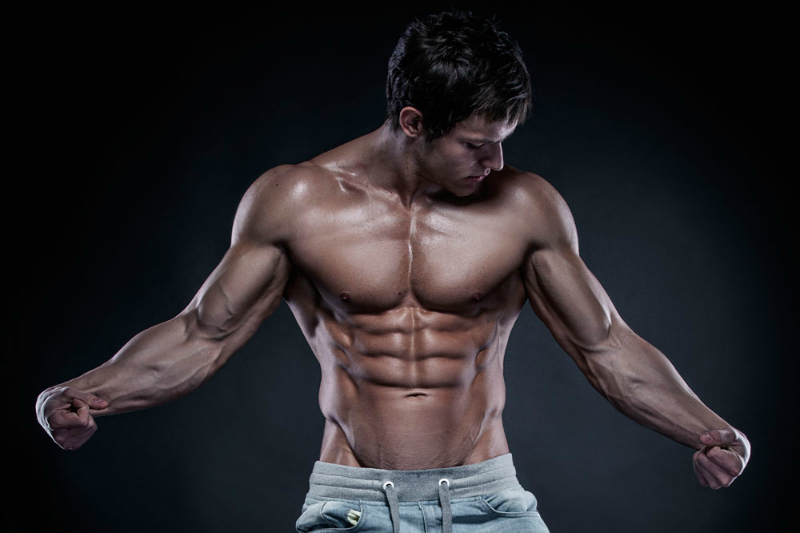
A “muscle group” is exactly what it sounds like—a group of muscles situated close together on your body that perform similar movements.
When it comes to building muscle, the six main muscle groups you should pay attention to are the:
- Chest
- Back
- Arms
- Shoulders
- Legs
- Calves
Categorizing muscles into units like this helps us better organize and prioritize our training.
If you want to build a bigger upper body, for instance, it doesn’t make sense to train your lower body as often. Yet that’s exactly what you’ll get if you follow many full-body workout plans or powerlifting routines.
Read: The Definitive Guide to Full-Body Workout Routines
That can work fine if you’re only training two to three times per week, but if you increase your training frequency you can quickly end up overtrained or injured.
On the other hand, many people focus too much on trying to isolate individual muscles like the biceps.
Every exercise uses a variety of surrounding muscles, so there isn’t much point in trying to only grow a single muscle. Rather, you should look at them as units, or muscle groups.
What’s more, this single-minded focus on training one muscle often results in muscle imbalances where certain muscles are disproportionately larger than others. This is visually unappealing and can set you up for an increased risk of injuries.
Instead, you want to train all of six of your major muscle groups so that you have a symmetrical, healthy, “aesthetic” physique.
The main muscle groups you want to train are the . . .
- Chest
- Back
- Arms
- Shoulders
- Legs
- Calves
Some people get even more granular and divide the body up into smaller muscle groups like the . . .
. . . but this level of precision isn’t necessary.
So long as you train the six major muscle groups listed above, all of these minor muscle groups will also become well developed.
Figuring out how to train all six of these major muscle groups in your workout program isn’t easy, though. You have to thread the needle between training each muscle group enough to keep gaining muscle and strength, without developing muscle imbalances or injuries.
That’s why I put together 12 weeks’ worth of free workout programming for optimally training all six of your major muscle groups. This program incorporates all of the scientific principles you’ll learn about in this article, and has helped thousands of men and women like you build a body they’re proud of.
All you have to do to get access to these training plans is enter your email address in the form below.
Major Muscle Group #1: Chest
The main muscle of the chest is the pectoralis major, or “pec” major.
Here’s what it looks like:
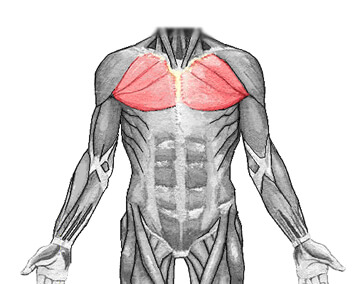
The chest muscle’s main function is to bring the upper arm across the body.
Unlike most other muscles, though, the fibers of the chest muscle aren’t all aligned in the same direction.
As you can see, the pec major has multiple “heads,” or places where the muscle fibers attach to the skeleton.
There’s a sternocostal head, which attaches the sternum and ribcage to your upper arm, and a clavicular head, which attaches your collarbone to your upper arm.
Why is this important?
Well, how a muscle attaches to the surrounding skeleton changes how you should train it.
Exercises that involve pushing the arms in front of the chest, like the flat and decline bench press, emphasize the larger sternocostal head of the pecs.
Exercises that involve moving the arms up and away from the chest, like the incline and reverse-grip bench press, emphasize the smaller clavicular head.
Read: How to Create the Ultimate Upper Chest Workout
Thus, if you want to develop a full, proportionate, well-defined chest, you want to focus on chest exercises like these:
Summary: The chest muscle is composed of two sections, or “heads”—the sternocostal and clavicular head, and you should use exercises that target both heads to maximize muscle growth.
Muscle Group #2: Back
The four muscles that make up the bulk of the back, and that we want to focus on developing, are the . . .
- Trapezius
- Rhomboids
- Latissimus dorsi
- Erector spinae
Here’s how they look:
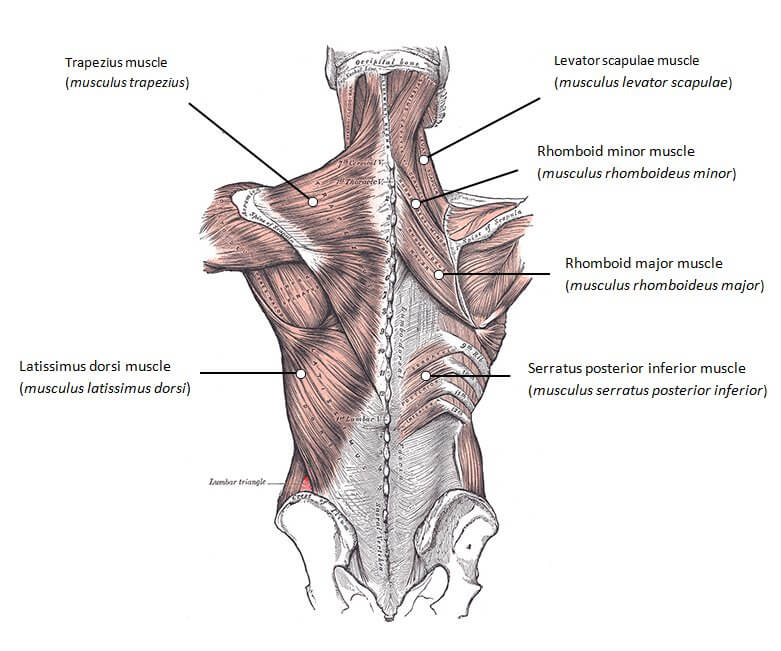
(The erector spinae aren’t shown on the above chart, but they are the lower back muscles that occupy the gray area at the bottom.)
There are a few smaller bundles of muscle that matter as well, such as the teres major and minor, and the infraspinatus. You can see them here:
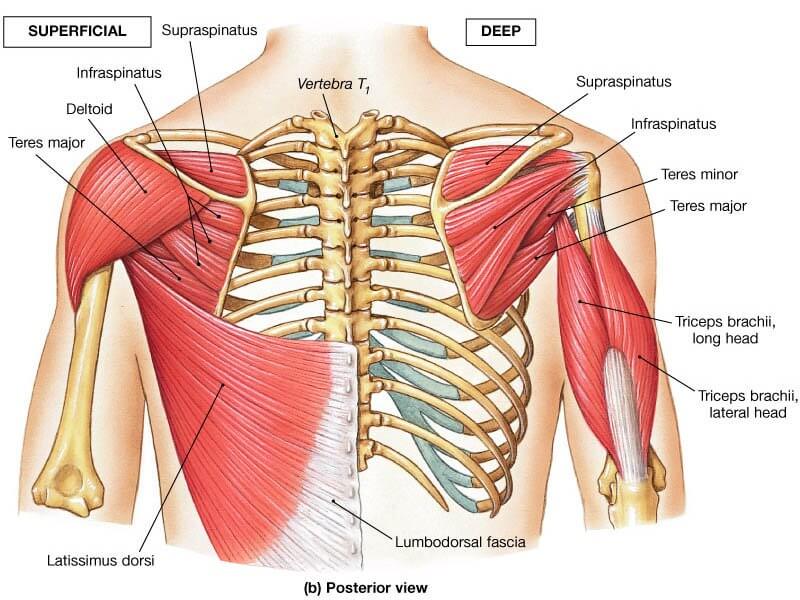
As you can see, the lats attach your upper arm to your back to form a winglike shape.
Read: The 8 Best Exercises for Building Bigger & Stronger Lats (As Fast As Possible)
Your traps connect your spine to your shoulder blades.
Read: The 10 Best Exercises for Building Bigger & Stronger Traps (As Fast As Possible)
The spinal erectors run parallel to your spine, and do exactly what you’d expect—keep your spine stabilized and upright.
The rhomboids stabilize your shoulder blades by linking them to your spine.
Now, here’s the goal in terms of overall back development:
- Large, but not overdeveloped, traps that establish the upper back.
- Wide lats that extend low down the torso, creating that pleasing V-taper.
- Bulky rhomboids that create “valleys” when flexed.
- Clear development and separation in the teres muscles and infraspinatus.
- A thick, “Christmas tree” structure in the lower back.
Many people neglect directly training this muscle group because it isn’t a “mirror muscle.” That’s a mistake, though, because developing a wide, thick, defined back is one of the best ways to take your physique from “decent” to “exceptional.”
If that’s your goal, then you want to focus on back exercises like these:
In other words, you want to focus on compound exercises that involve either vertical or horizontal pulling.
Summary: Your back is made up of four large muscles, and the best exercises for training them all involve horizontal and vertical pulling, such as the barbell deadlift, lat pulldown, and dumbbell row.
Muscle Group #3: Arms
The arms are made of four primary muscles:
- Biceps brachii
- Biceps brachialis
- Triceps
- Forearms
The biceps (or, formally, biceps brachii) is a two-headed muscle that looks like this:

Another muscle you need to know about is the biceps brachialis, which lies beneath the biceps brachii and assists it in flexing at the elbow.
Here’s how it looks:
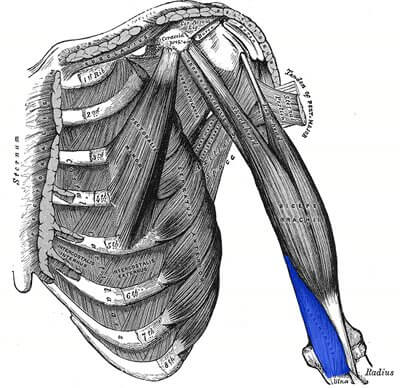
While this muscle isn’t nearly as prominent as the biceps brachii, it plays an important role in the overall appearance of your arms.
When well developed, the brachialis looks like a “knot” in between the biceps brachii and triceps, and it noticeably impacts the overall appearance of the arms.
First, it cleanly separates the biceps and triceps when flexed, which better showcases each.
Second, it pushes the biceps brachii up, giving you a better “peak” when flexing.
Here’s a picture that I think illustrates my point:
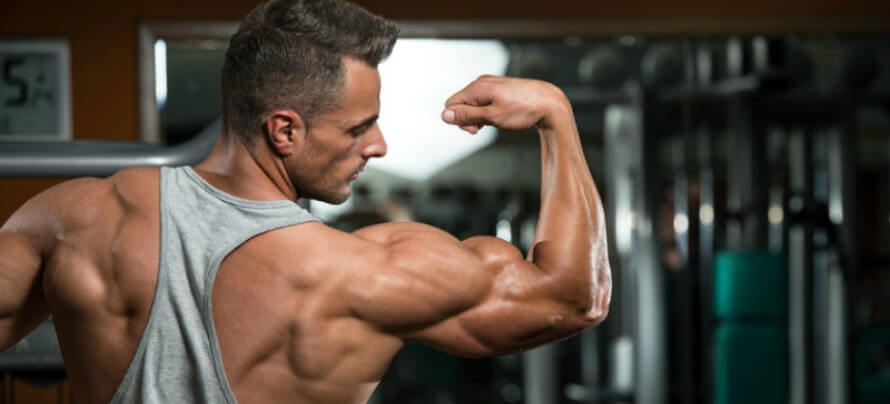
The biceps’ job is to flex the arm, or bring your forearm closer to your upper arm. They also supinate the elbow, which means turning your hand upward as if you were about to catch something.
To maximally stimulate the biceps, you typically want to keep your hands turned palm-up toward the ceiling.
The triceps, or triceps brachii, do the opposite job of the biceps, pushing your forearm away from your upper arm.
This is what they look like:
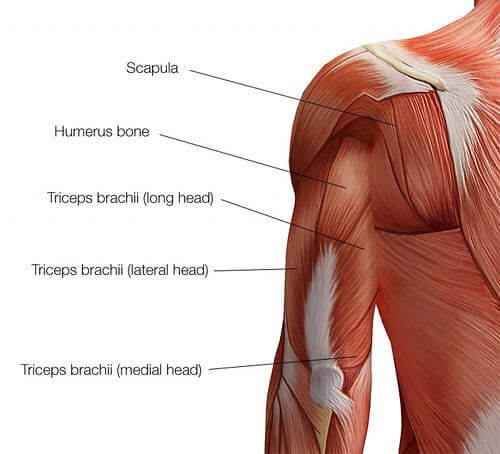
As you can see, the three heads combine to form the distinctive “horseshoe” that can become quite pronounced, when properly developed.
Here’s a shot of Mike, showing what this looks like:
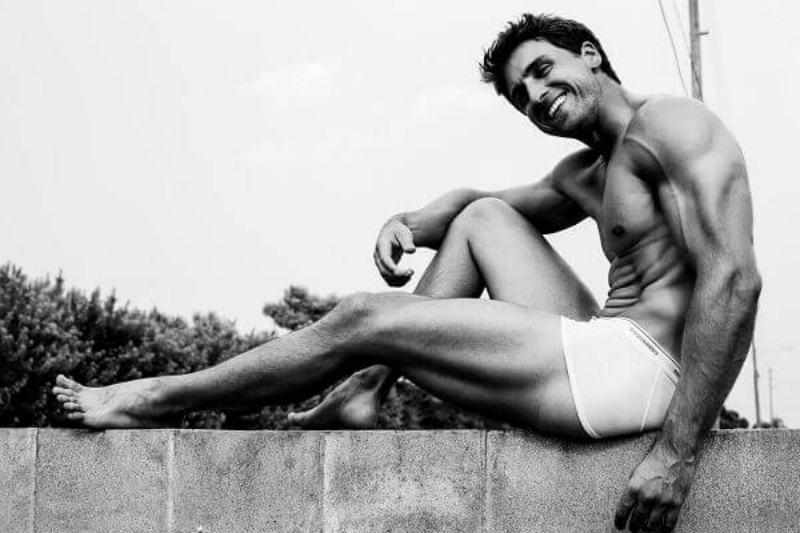
When most people think of arm muscles, they think of the biceps.
Big biceps = big arms . . . right?
Not necessarily.
Ironically, the biceps contribute substantially less to overall arm size than the triceps, which are a much larger muscle group.
You can see this clearly in a shot like this:

Small triceps mean small, disproportionate arms, regardless of the size of the biceps.
Last but not least are the forearms, which are comprised of several small muscles:

Forearms are like the calves of the arms.
They aren’t the immediate focus, but if they’re underdeveloped, it’s sorely obvious. If they’re well developed, however, it greatly enhances the whole appearance of the limbs.
You’ll want to train all of these muscles to develop a set of standout arms.
Luckily, most arm exercises (and heavy barbell exercises in general) also train the forearms.
So, if you want to develop strong, muscular, proportionate biceps, triceps, and forearms, you want to focus on arm exercises like these . . .
- Barbell curl
- Dumbbell curl
- EZ-bar curl
- Skull crusher
- Triceps pressdown (with rope or metal handle)
- Dips
- Triceps overhead press (with cable or dumbbell)
- Close-grip bench press
- Chinups
- Pullups
(As you can see, there’s a certain degree of overlap between exercises for different muscle groups. For example, most back exercises also train the biceps, and most chest exercises also train the triceps and forearms).
Summary: The arms are made up of the biceps, triceps, forearm muscles, and a few other small muscles. You should include some direct training for the biceps and triceps, but you generally don’t need to train the forearms directly.
Muscle Group #4: Shoulders
Your shoulders are comprised of three major muscles known as deltoids, and here’s how they look:
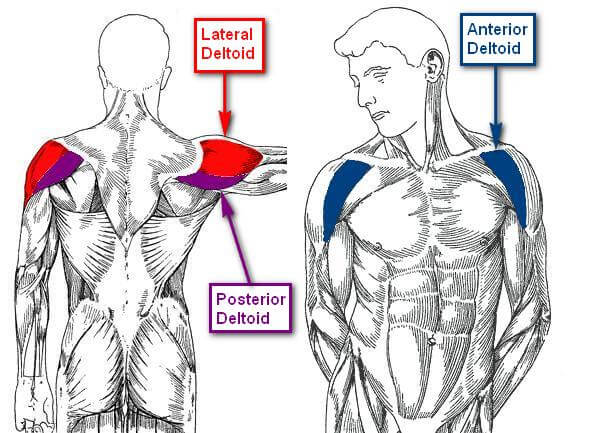
The three heads of the deltoids are the:
- Anterior head (front)
- Lateral head (middle)
- Posterior head (rear)
The delts mainly work to stabilize nearby muscle groups like the pecs, lats, and biceps.
The rear delts help the lats and traps bring the arm behind you, the front delts help the pecs bring your arms in front of you, and your lateral delts help the traps, pecs, and other muscles around your neck and upper back raise your arm to the side.
This is important, because the angle at which you press or pull will change how much the delts are trained relative to other muscles. For example, an overhead press will use more lateral delt than upper chest, and a barbell row will use more rear delt than a lat pulldown.
It’s very important to develop all three heads of this muscle because if one is lagging, it will be painfully obvious.
In most cases, the lateral and posterior deltoids need the most work because the anterior deltoids do get trained to some degree in a good chest workout, and nobody skips chest day.
Chest training doesn’t adequately train the other two deltoid heads though, which is why it’s best to include some additional exercises that also train your lateral and posterior delts.
If you want to develop all three heads of your deltoids, you want to focus on shoulder exercises like these . . .
Summary: The shoulders are made up of the anterior, lateral, and posterior heads, and it’s important you include exercises in your program that train all three heads to achieve a balanced, proportionate look.
Muscle Group #5: Legs
The upper portion of the legs are made up of several major muscle groups:
- The quadriceps
- The hamstrings
- The glutes
Technically, the calves are also part of the legs, but since they require a very different style of training we’ll address those separately.
Each of these muscle groups are best trained by different exercises, and each has “special needs” if you’re going to achieve maximal development and definition.
There are quite a few different leg muscles, so let’s take a moment to discuss them separately.
The Quads
The quadriceps are a set of four large muscles on the front of your legs:
- The vastus lateralis
- The vastus medialis
- The vastus intermedius
- The rectus femoris
(Interestingly, new research indicates there’s a fifth muscle involved, so maybe we should be talking about the quintraceps instead?)
Here’s how they look:
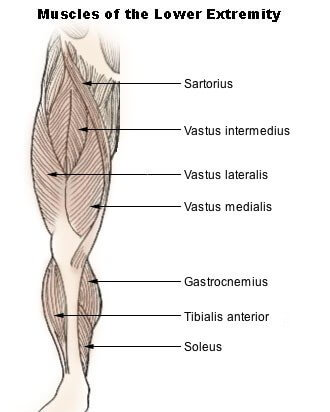
The quadriceps muscles work together to extend the knees and flex the hips.
Thus, quadriceps exercises bring the hip from an extended to a flexed position (bending the joint) and bring the knee from a flexed to an extended position (straightening the joint).
When the quads are well developed, they form the centerpiece of the legs.
Case in point:

Now, many people believe that you can get all of the quad development you need from lots of heavy back squatting.
The back squat is a fantastic exercise for your quads (and entire lower body), but for optimal quad development, you should periodically do others as well, including front squats and lunges.
As you’ll see, the best quads exercises that you can do are mostly compound exercises, and mostly involve using free weights.
If you want to maximally develop your quads, you want to focus on exercises like the . . .
The Hamstrings
The hamstrings are a group of three muscles on the back of your legs:
- Semitendinosus
- Semimembranosus
- Biceps femoris
Here’s how they look:
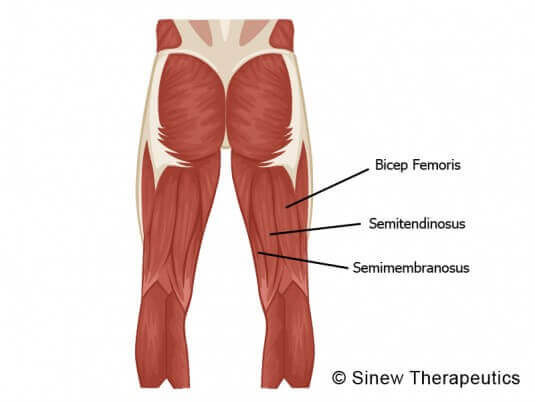
The hamstrings work together to flex the knee, as when you’re doing a hamstring curl, and extend the hips during exercises like the hip thrust and deadlift.
The biceps femoris is also split into two “heads” or sections, just like the biceps in your arm.
Unlike the biceps, however, the hamstrings tend to be one of the most neglected muscles of the lower body.
The quads get most of the attention because they’re larger and more visible, and this can create a muscular imbalance between the front and back of the thighs that looks strange and may increase the risk of injury.
Many people also think that squatting is all you need for your hamstrings, and this is mistaken.
While the squat does involve the hamstrings, the quads do the lion’s share of the work. And this is especially true with the type of squatting that you often see in the gym (quarter- and half-repping).
So, a good rule of thumb is to always include exercises that target your hamstrings in your lower body workouts, in addition to your quad-dominant exercises.
If you want to maximally develop your hamstrings, you want to focus on exercises like the . . .
The Glutes
The gluteus muscles, or “glutes,” are comprised of three muscles that form your butt:
- The gluteus maximus
- The gluteus minimus
- The gluteus medius
Here’s how they look:
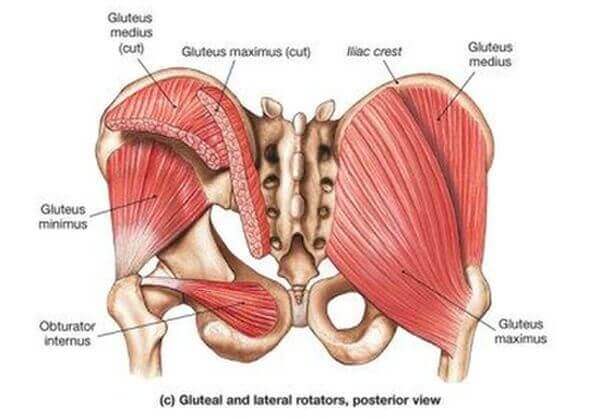
They’re for more than just show, too.
Together, they play a key role in stabilizing your body during all kinds of movement, and generating force in exercises like the deadlift and squat.
Now, if you’re training your lower body correctly, you don’t have to do additional training for your glutes.
That said, if you feel your glutes are a weak point in your physique, or if you just want maximum booty, then you’ll want to include exercises that specifically target them.
Read: The 7 Best Butt Exercises That Will Give You Glorious Glutes
If you want to maximally develop your glutes, you want to focus on exercises like the . . .
Summary: The upper portion of the legs are made up of the quadriceps, hamstrings, and glutes, and you want to include exercises that train each of these muscle groups in your workout routine to maximize your leg size and definition.
Muscle Group #6: The Calves
The calves are made up of two powerful muscles:
- The gastrocnemius
- The soleus
The gastrocnemius is the large (or not so much) muscle you see when you look at your calf. The soleus is a deep muscle that lies underneath the gastrocnemius.
Here’s how they look:
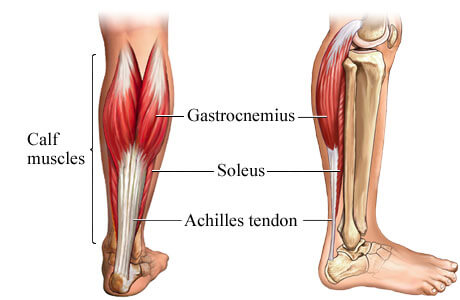
These two muscles work together to manipulate the foot and ankle joint and are involved in knee flexion as well.
When it comes to looks, we’re most concerned with the gastrocnemius, but a properly developed soleus is critical as well because it supports the larger gastroc both in function and visual size.
Due to the way the calf muscles are oriented, it’s best to use different exercises to train each.
There are really only two types of exercises that you can do to effectively train your calves.
1. Calf pressing
If you’re pressing your toes against resistance, it’s a calf press.
2. Calf raising
If you’re using your calves to raise and lower your body against gravity, it’s a calf raise.
And those break down into seated and standing variations.
Standing calf presses and raises are done with the legs straight and emphasize the gastrocnemius.
Seated calf raises are done, well, seated and with the legs bent, which emphasizes the soleus.
It’s important to do both standing and seated calf work and to emphasize your standing exercises if you want to get the most out of your calf workouts.
The reason for doing both is making sure that your soleus isn’t neglected and the reason for doing more standing than seated work is you want to focus most of your effort on training your gastrocnemius.
There aren’t that many worthwhile calf exercise variations you can do, but here are the ones you want to focus on . . .
- Standing calf raise machine
- Standing barbell calf raise
- Seated calf raise machine
- Donkey calf raise machine
- Single-leg bodyweight calf raise
Summary: The calves are made up of the gastrocnemius and soleus, and you want to do a combination of both standing and seated calf exercises to train both muscles.
What About the Core?
The “core,” or the group of muscles around your midsection, is often counted as the seventh major muscle group.
It’s made up of the rectus abdominis, transverse abdominis, and the internal and external obliques. These muscles all stabilize the spine and help with spinal flexion, bringing your chest closer to your hips.
For the sake of completeness, you could call the “core” a muscle group. In the context of building a workout plan, though, that’s not typically necessary.
This is because if you’re training the other six major muscle groups with heavy compound exercises, your core is getting enough indirect training that you don’t really need a separate workout just for your core.
This doesn’t mean that direct core training is useless, however.
Ab and core exercises aren’t required to get a six-pack, but they can improve your abdominal definition. That’s why you’ll find a little ab training tacked onto the end of some of your other workouts in the plans below.
That brings us to the next question—how are you supposed to pair these muscle groups together?
The Best Muscle Groups to Workout Together
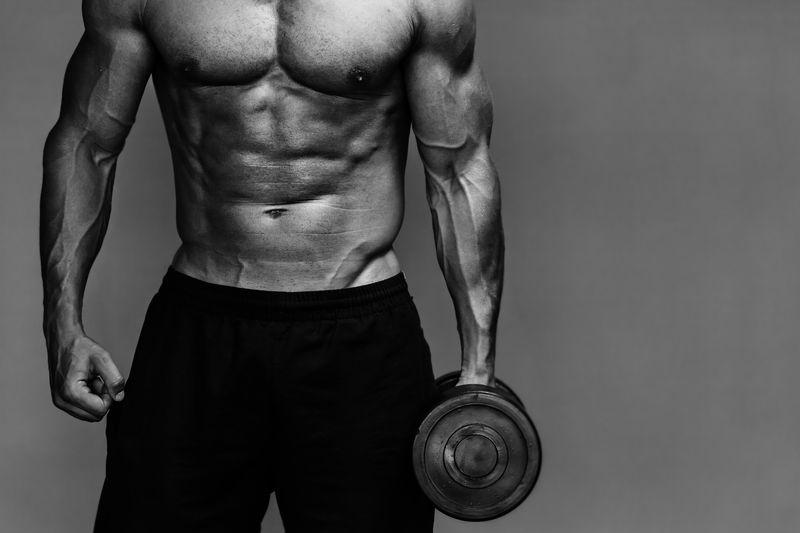
When it comes to deciding which muscle groups to train on the same day and in the same workout, it really comes down to how quickly you can recover from your workouts.
Depending on your sleep, diet, and training, it generally takes about 72 to 96 hours for your muscles to fully recover after a workout.
Research has shown that even in resistance-trained, college-aged men, full muscle recovery can take anywhere from 48 to 96 hours.
This is in line with one of the most thorough reviews to date, which shows that training each muscle group every 5 to 7 days tends to be the sweet spot for building muscle.
That said, just because a muscle isn’t completely recovered doesn’t mean you can’t benefit from training it again.
For example, the latest research shows that training a muscle group closer to twice per week is likely optimal for muscle and strength gain. What’s more, other studies show that as you inch toward your genetic potential for muscle growth, you may benefit from training each muscle group more often than this.
Read: The Definitive Guide to Full-Body Workout Routines
This kind of high-frequency training can be an issue if you’re doing a lot of heavy, compound barbell exercises, though.
You see, most compound barbell exercises hit more than one muscle group.
For example, when you bench press, your chest is the prime mover, but your triceps and shoulders also pitch in.
When you deadlift, you may be focused on growing your back, but your hamstrings and glutes also take a beating.
In other words, most of the best exercises train more than one muscle group at a time.
That’s one of the reasons heavy, compound barbell training is so effective.
It’s also why it’s easy to overtrain if you do too much full-body barbell training.
That’s why the following 5-day workout routine ensures you get around 80% of your weekly sets from heavy, compound weightlifting. The remaining 20% of your weekly sets are from isolation exercises that train particular muscle groups without causing the same fatigue you’d get from heavy, compound exercises.
In other words, this workout routine strikes a good balance between adequately training each muscle group and providing enough recovery so you can keep progressing.
(And if you need a little extra help getting fired up for workouts that involve a lot of heavy barbell training, try Legion’s pre-workout powder, Pulse.)
Summary: You generally want to train each major muscle group twice per week to maximize strength and muscle gain.
The Legion 5-Day Workout Routine
Day 1
Push
Day 2
Pull & Calves
Day 3
Upper Body & Core
Day 4
Legs
Day 5
Upper Body & Core
This is one of the best all the workout schedules for maximizing muscle growth and strength.
Each workout takes about 45 minutes, each muscle group gets maximal stimulation, your muscles and joints get enough time to recover, and it fits perfectly with most people’s schedules (Monday through Friday with the weekends off).
The 5-day routine also gives you room to add some extra sets for your weak points.
For instance, many guys complain about lack of chest development and thus can add 3 sets of incline pressing to day 4, which can be done before the shoulder training.
Many women are focused on improving their butt and legs and thus can add 3 sets of squats to day 2, done after deadlifts, and 3 sets of hip thrusts to day 5, done after legs.
If you don’t want to train five days per week, you have a few more options to make sure each muscle group gets the attention it deserves.
The Legion 4-Day Workout Routine
Day 1
Push & Core
Day 2
Pull & Calves
Day 3
Upper Body & Core
Day 4
Legs
If you aren’t ready to commit to four days per week, you can still train each muscle group in this three-day per week routine . . .
The 3-Day Workout Routine
Day 1
Push & Core
Day 2
Pull & Calves
Day 3
Legs
This workout routine is almost identical to a traditional push/pull/legs routine, except with a bit more isolation work to bring up stubborn muscle groups like the shoulders.
If you’d like to give these routines a whirl, just enter your email address in the form below and I’ll send you 12-weeks’ worth of workout programming, including exactly what exercises to do and how many reps and sets you should do for each exercise.
Now that you know what muscle groups to train together, let’s look at what exercises you should use to train them.
The Best Exercises for Each Muscle Group
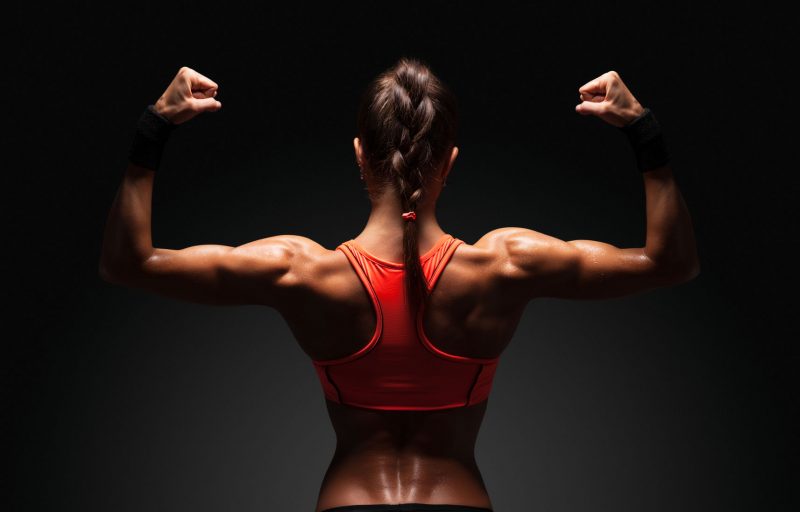
There are two primary types of weightlifting exercises: compound exercises and isolation exercises.
Compound exercises involve multiple major muscle groups and require the most whole-body strength and effort. Examples of compound exercises are the squat, deadlift, bench press, and military press.
Isolation exercises involve one muscle group and require significantly less whole-body strength and effort. Examples of isolation exercises are the biceps curl, cable flye, and side lateral raise.
If you want to build maximum muscle and strength, you want to focus on compound exercises in your workouts for two reasons:
- You train more muscle groups with each rep, making your workouts more efficient.
- You can use more weight, which means you can expose your muscles to greater levels of mechanical tension (the key driver of muscle growth).
Isolation exercises can and should be used to develop smaller, stubborn muscles like the shoulders and arms and support the growth of larger muscle groups, but they should never be the focus of a workout routine for natural weightlifters.
Just knowing that isn’t enough to build an effective workout routine, though, because there are quite a few compound exercises you could do for each muscle group.
Which specific exercises are the best for building each muscle group? Here’s a handy list taken from two of Mike’s books, Bigger Leaner Stronger and Thinner Leaner Stronger . . .
The Best Chest Exercises
- Incline Barbell Bench Press
- Incline Dumbbell Bench Press
- Flat Barbell Bench Press
- Flat Dumbbell Bench Press
- Dip (Chest Variation)
These are the exercises you must master if you want to build an impressive chest. Period.
Forget cable work, dumbbell flyes, push-up variations, machines, and every other type of chest exercise out there for now.
They just aren’t nearly as effective as the above core, foundation-building lifts and are only for intermediate and advanced weightlifters who have already paid their dues with the heavy pressing to build big, strong pecs.
The Best Back Exercises
- Barbell Deadlift
- Barbell Row
- One-Arm Dumbbell Row
- Pull-Up
- Lat Pulldown (Front and Close-Grip)
- T-Bar Row
- Seated Cable Row (Wide- and Close-Grip)
- Chin-Up
- Barbell Shrug
The deadlift is, by far, the most effective back exercise you can do. You just can’t beat it for all-around development and strength, and that’s why I recommend you do it every week.
When combined with a small selection of other pulling exercises like the lat pulldown, one-arm dumbbell row, and cable row, you have a winning combination for building an impressive back.
Next up we have everyone’s favorite—arm exercises. You’ll want to include exercises for both your biceps and triceps for maximum arm development.
The Best Biceps Exercises
- Barbell Curl
- E-Z Bar Curl
- Dumbbell Curl
- Hammer Curl
- Chin-up
Short and sweet. This is all you need to build big biceps.
The Best Triceps Exercises
- Close-Grip Bench Press
- Seated Triceps Press
- Dip (Triceps Variation)
- Lying Triceps Extension (“Skullcrusher”)
- Triceps Pushdown
Like with biceps, you just don’t need much variety in your choices of triceps exercises to get those “horseshoe” tris.
The Best Shoulder Exercises
- Seated Barbell Military Press or Standing Barbell Military Press
- Seated Dumbbell Press or Arnold Dumbbell Press
- Dumbbell Side Lateral Raise or One-Arm Dumbbell Side Lateral Raise
- Rear Delt Raise (Bent-Over or Seated)
- Face Pull
- Barbell Rear Delt Row
- Dumbbell Front Raise
As you can see, I’m a fan of pressing. As with the chest, you just can’t beat heavy pressing for developing your shoulders. And as a natural weightlifter, you’re going to need as much help as you can get in this department.
If all you do is press, however, you’ll find that your middle and rear heads of your deltoids fall behind in development. This is why a good shoulder workout trains all three heads of the muscle by having you press as well as do side raises and something for the rear delts.
Just like any other muscle group, the shoulders can benefit from higher-rep work, but you have to emphasize the heavy weightlifting if you want them to grow.
The Best Leg Exercises
- Barbell Squat
- Front Squat
- Hack Squat (sled, not barbell)
- Single Leg Split Squat (Barbell or Dumbbell)
- Leg Press
- Barbell Lunge (Walking or In Place)
- Dumbbell Lunge
- Romanian Deadlift
- Leg Curl (Lying or Seated)
Working legs is very simple. Rule #1: Always do squats. Rule #2: Always do squats. Rule #3: You get the point.
The bottom line is that every leg workout should begin with either the back or front squat (or some squat variation).
The Best Calf Exercises
- Standing Calf Raise
- Seated Calf Raise
- Calf Press on the Leg Press
- Donkey Calf Raise
The calves respond particularly well to a combination of low- and high-rep training. This is probably because the composition of the muscle fibers of the calf muscles can vary significantly from person to person.
Read: What 30 Studies Say About Your Muscle Fiber Type and Muscle Growth
Even if you were dealt a bad hand when it comes to calf genetics, they will grow if you give them enough volume and effort.
The Best Ab Exercises
- Cable Crunch
- Captain’s Chair Leg Raise
- Hanging Leg Raise
- Air Bicycle
- Ab Wheel Rollout
Although you don’t need to directly train your abs if you’re happy with your ab development, it’s worth using a handful of the right ab exercises to develop your core if you feel it’s lacking.
If you want to learn more about the best ab workouts, check out this article:
Read: The Ultimate Ab Workouts: The 5 Best Ab Exercises for Getting a Six Pack
How to Correct Muscle Group Imbalances
After your first few months of lifting weights, you’ll quickly realize certain parts of your body respond faster to strength training than others.
For example, my legs, calves, and butt grew quickly after I started lifting weights, my chest, triceps, and shoulders grew slower but consistently, and my biceps, chest, and back have taken their sweet time to catch up to the rest of my muscle groups.
In many cases, muscle imbalances like these will simply work themselves out over time as you get more training experience. If they don’t, though, or you don’t want to wait to find out, it’s worth doing more volume (sets or reps) for your lagging muscle groups and less for your stronger muscle groups.
If you want to learn how to program your workouts to bring up your weak points and maintain your strong points, check out this article:
The Easy Way to Find and Fix Muscle Imbalances
The Bottom Line on Muscle Groups
There are countless theories on which muscle groups you should train on the same day.
The answer, though, really boils down to a few simple principles:
- Train each muscle group every 5-7 days to allow for sufficient recovery.
- Use the correct exercises for training each muscle group.
- Combine muscle groups that perform similar movements (like chest and triceps).
The most tried-and-true workout routine for accomplishing all of those goals, is this:
Day 1: Push (Chest)
Day 2: Pull & Calves (Back)
Day 3: Upper Body (Shoulders, Arms)
Day 4: Legs
Day 5: Upper Body (Chest, Arms)
If you don’t want to train five days per week, you can make this work as a 3- or 4-day routine, too.
Follow that workout plan and eat right, and you’ll have no trouble building muscle.
What’s your take on muscle groups? Have anything else to share? Let me know in the comments below!
Looking for workouts to effectively train all six major muscle groups? Check out these articles:
The 12 Best Science-Based Strength Training Programs for Gaining Muscle and Strength
The Definitive Guide on How to Build a Workout Routine
How to Create the Ultimate Muscle Building Workout
+ Scientific References
- Gollnick PD, Sjödin B, Karlsson J, Jansson E, Saltin B. Human soleus muscle: A comparison of fiber composition and enzyme activities with other leg muscles. Pflügers Arch Eur J Physiol. 1974;348(3):247-255. doi:10.1007/BF00587415
- Brad J. Schoenfield. The mechanisms of muscle hipertrophy and their applicantion to resistence trainning. J Strength Cond Res 2010 Natl Strength Cond Assoc. 2010;24(10):2857-2872. https://www.ncbi.nlm.nih.gov/pubmed/20847704. Accessed October 11, 2019.
- Wernbom M, Augustsson J, Thomeé R. The influence of frequency, intensity, volume and mode of strength training on whole muscle cross-sectional area in humans. Sport Med. 2007;37(3):225-264. doi:10.2165/00007256-200737030-00004
- McLester JR, Bishop PA, Smith J, et al. A series of studies–a practical protocol for testing muscular endurance recovery. J strength Cond Res. 2003;17(2):259-273. http://www.ncbi.nlm.nih.gov/pubmed/12741861. Accessed October 11, 2019.
- Bishop PA, Jones E, Woods AK. Recovery from training: a brief review: brief review. J strength Cond Res. 2008;22(3):1015-1024. doi:10.1519/JSC.0b013e31816eb518
- Yavuz HU, Erdağ D, Amca AM, Aritan S. Kinematic and EMG activities during front and back squat variations in maximum loads. J Sports Sci. 2015;33(10):1058-1066. doi:10.1080/02640414.2014.984240
- Arendt E, Dick R. Knee Injury Patterns Among Men and Women in Collegiate Basketball and Soccer. Am J Sports Med. 1995;23(6):694-701. doi:10.1177/036354659502300611
- Holcomb WR, Rubley MD, Lee HJ, Guadagnoli MA. Effect of hamstring-emphasized resistance training on hamstring:quadriceps strength ratios. J Strength Cond Res. 2007;21(1):41-47. doi:10.1519/R-18795.1
- Grob K, Ackland T, Kuster MS, Manestar M, Filgueira L. A newly discovered muscle: The tensor of the vastus intermedius. Clin Anat. 2016;29(2):256-263. doi:10.1002/ca.22680
- Trebs AA, Brandenburg JP, Pitney WA. An electromyography analysis of 3 muscles surrounding the shoulder joint during the performance of a chest press exercise at several angles. J strength Cond Res. 2010;24(7):1925-1930. doi:10.1519/JSC.0b013e3181ddfae7
- Arendt E, Dick R. Knee Injury Patterns Among Men and Women in Collegiate Basketball and Soccer. Am J Sports Med. 1995;23(6):694-701. doi:10.1177/036354659502300611
- Serrano JA. Effects of Resistance Training Frequency on muscle strength, activity and mass during 24- weeks intervention in the elderly. 2016:1-87. doi:10.1007/s40279-016-0543-8
[ad_2]
Source link

